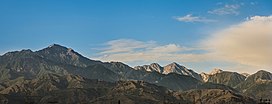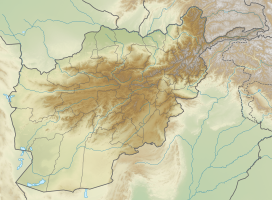Spīn Ghar
| Spīn Ghar / Safed Koh | |
|---|---|
Urdu: سفیدکوه | |
 | |
| Highest point | |
| Peak | Mount Sikaram, Afghanistan–Pakistan Border |
| Elevation | 4,755 m (15,600 ft) |
| Coordinates | 33°58′N 70°22′E / 33.967°N 70.367°E |
| Geography | |
| Countries | Afghanistan and Pakistan |
| Provinces | Nangarhar, Logar, Paktia in Afghanistan and Khyber Pakhtunkhwa in Pakistan |
 | |

The Spīn Ghar
Geography



The range extends from the
The highest peak is
The closest cities to the Spīn Ghar are Jalalabad to the north; Gardez to the west; and Khost, and Parachinar in Pakistan to the south.
The range between
Geology
The White Mountains are part of the western rim that separates the
The base of the mountains consists of
On the southern flank of the Sikaram Sar follow from 2500 m from bottom to top: alluvial soils in valleys, limestone and dolomite up to 4000 m, an intermediate zone of slate at 4000 m, above crystalline rock.[13]
Fauna
A 20,000 hectare biotope in the southwest of Spīn Ghar is listed as an important bird area in Afghanistan.[14]
Agriculture and forestry
Above the nearly barren lower slopes, forests of pine and
The rivers of the White Mountains serve the irrigation of the fields in the densely populated river valleys,[15] which allows the pelvis of Jalalabad multiple harvests. Wheat, maize, various types of vegetables (onions, green beans, okra, tomatoes, etc.), cotton, opium poppies, lemons, sugar cane, and olives are also grown around Jalalabad.[16][17][18] The Bara high valley in the southeast of the range is one of the most intensively used agricultural areas of the Pakistani tribal areas under Khyber Pakhtunkhwa.[citation needed]
Older reports speak of rich orchards in the valleys of Spīn Ghar with mulberry and pomegranate trees.[19]
Wood from the eastern Afghan forests has been exported mainly to Pakistan since the 19th century, and in increasingly irresponsible quantities, so that Afghanistan imposed a complete export ban in 1975, which smugglers circumvented.[20][21] In addition to the actual forestry there is or was a collection economy for pistachio nuts and the edible seeds of Pinus gerardiana.[22]
Passes

There are a few notable mountain passes in or near the Spīn Ghar mountain range. The famous Khyber Pass crosses a spur of the Spīn Ghar. A second crossing, near Mount Sikaram, is called Peiwar Pass or Gawi Pass and connects Parachinar city on the Pakistani side with the Aryob Valley of Paktia Province, Afghanistan. The most viable route over the main ridge of the White Mountains is the Agam Pass (3586 m), over which the distance from Jalalabad to Parachinar is 92 km.[23]
History
The
According to
See also
- List of mountain ranges of the world
- List of highest mountains(a list of mountains above 7,200m)
- Environmental issues in Afghanistan
- Durand Line
- Koh-i-Baba
External links
References
- ^ a b Safīd Mountain Range in Encyclopædia Britannica, 2009
- ^ defect link: CIA document
- ^ Chisholm, Hugh, ed. (1911). . Encyclopædia Britannica. Vol. 23 (11th ed.). Cambridge University Press. pp. 994–995.
- ^ Oxford dictionary, 2014
- ^ Garren, William R., and Carl R. Page. 1987. Gazetteer of Pakistan: official standard names approved by the United States Board on Geographic Names. Washington, D.C.: Congressional Information Service. p.578
- ^ Safīd Mountain Range in: Universalium, 2010
- ^ defense.gov
- ^ Physical map of Afghanistan, University of Texas
- ^ Physical map of Afghanistan, www.ezilon.com
- ^ geographic.org
- ^ Paropamisus in The Columbia Encyclopedia, 6th ed.
- ^ John F. Shroder: Natural Resources in Afghanistan. Amsterdam u. a. 2014, S. 73–74 Vorschau. R. G. Bohanon, K. J. Turner: Geologic Map, AGS Open-File Report (509/510) 2005-1107-A. R. G. Bohanon, K. J. Turner: Geologic Map, AGS Open-File Report (511/512/517) 2005-1108-A
- ^ Siegmar W. Breckle: Ökologische Beobachtungen oberhalb der Waldgrenze des Safed Koh (Ost-Afghanistan). In: Vegetatio. 30,2 (1975), S. 89–97, hier S. 93 online
- ^ Biodiversity Profile of Afghanistan, United Nations Environment Programme, 2008 Archived 21 January 2023 at the Wayback Machine, S. 29
- ^ Vgl. Karten der bewässerten Gebiete und der Bevölkerungsdichte in Stephen G. Peter et al.: Summaries of Important Areas for Mineral Investment and Production Opportunities of Nonfuel Minerals in Afghanistan. 2011, S. 1440–1441 20 B
- ^ David Mansfield: All Bets are Off! Prospects for (B)reaching Agreements and Drug Control in Helmand and Nangarhar in the run up to Transition. 2013, S. 27. David Mansfield: “From Bad They Made It Worse” The concentration of opium poppy in areas of conflict in the provinces of Helmand and Nangarhar. 2014
- ^ Raphy Favre u. a.: Watershed Atlas of Afghanistan. Part III, Kabul 2004, S. 96 online
- ^ "Nangarhar Provincial Profile (2007)" (PDF). Archived from the original on 4 March 2010. Retrieved 11 September 2021.
{{cite web}}: CS1 maint: bot: original URL status unknown (link) - ^ The Imperial Gazetteer of India, 1908, vol 21, S. 349 online
- ^ Xavier de Planhol: Afghanistan XIII. Forests and Forestry. Encyclopædia Iranica Online
- ^ Daniel Balland: Boundaries III. Boundaries of Afghanistan. Encyclopædia Iranica Online
- ^ Erwin Grötzbach: Afghanistan. Darmstadt 1990, S. 122
- ^ Ludwig W. Adamec (Hrsg.): Historical and political gazetteer of Afghanistan. Vol. 6, Graz 1985, S. 16 online

